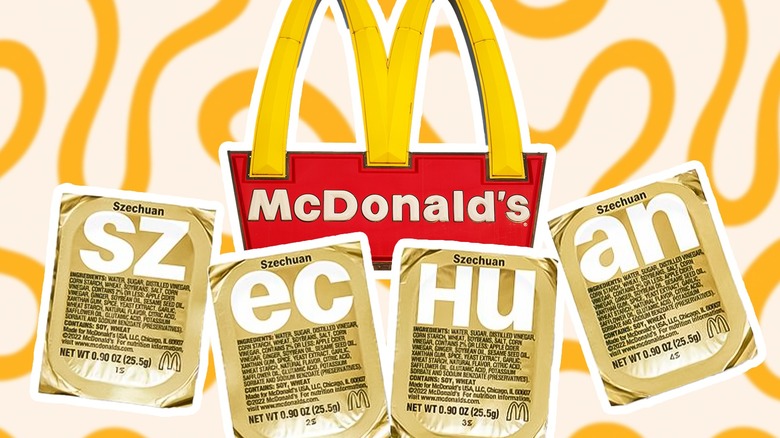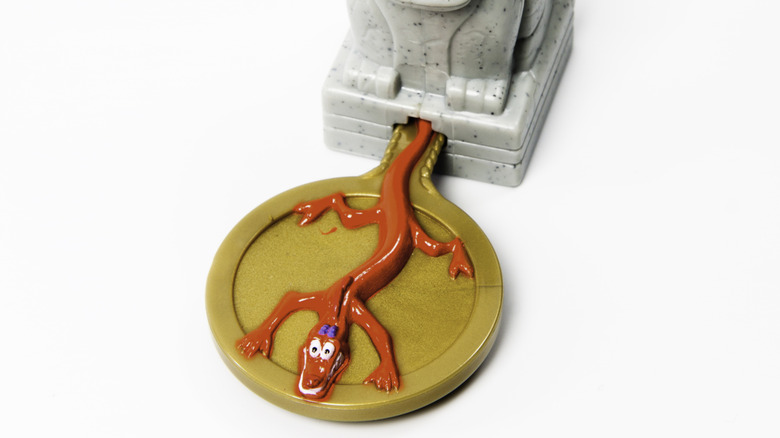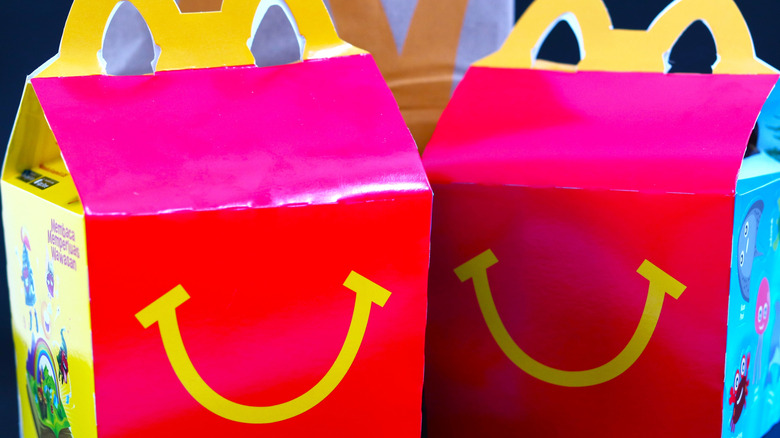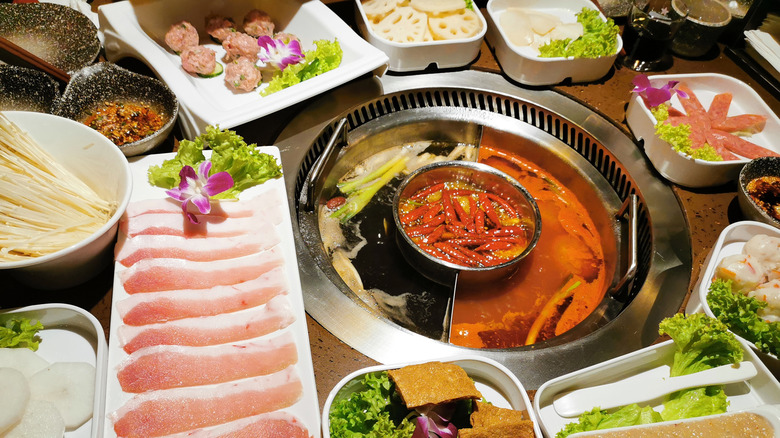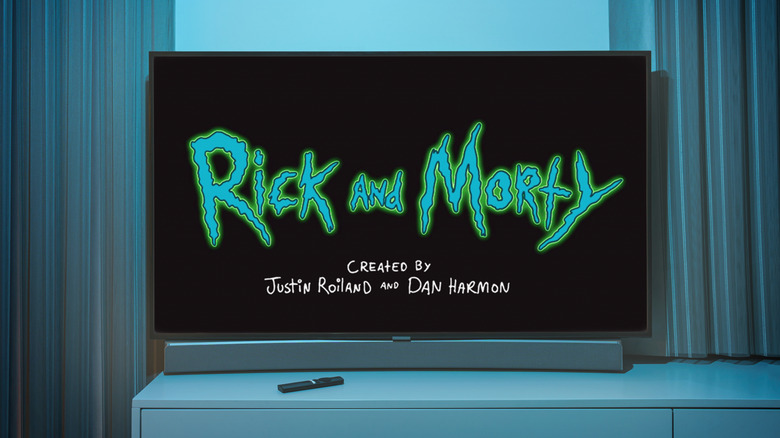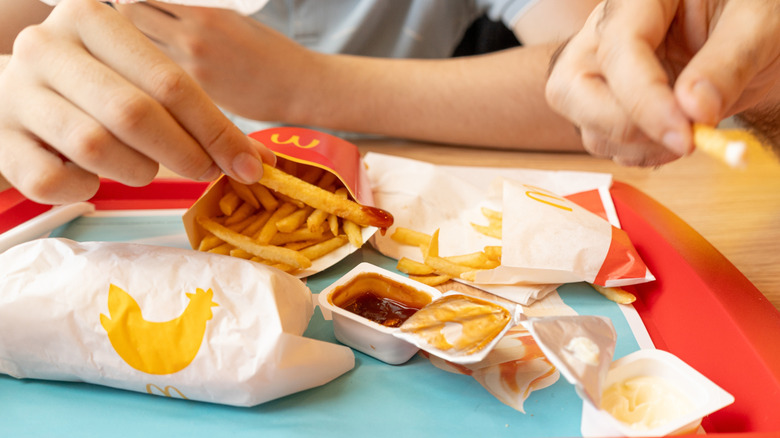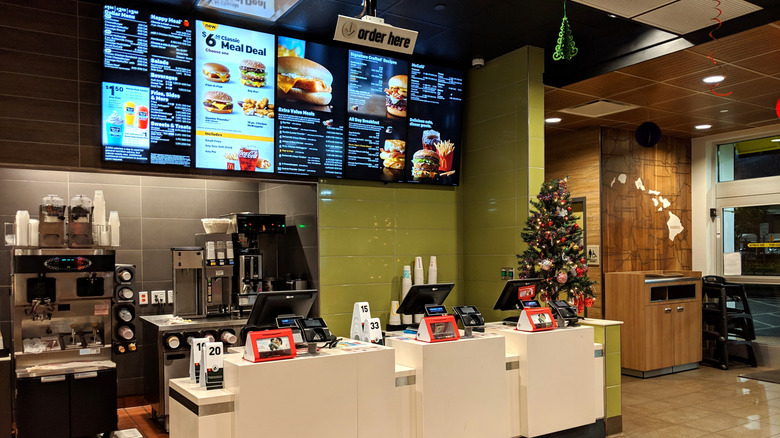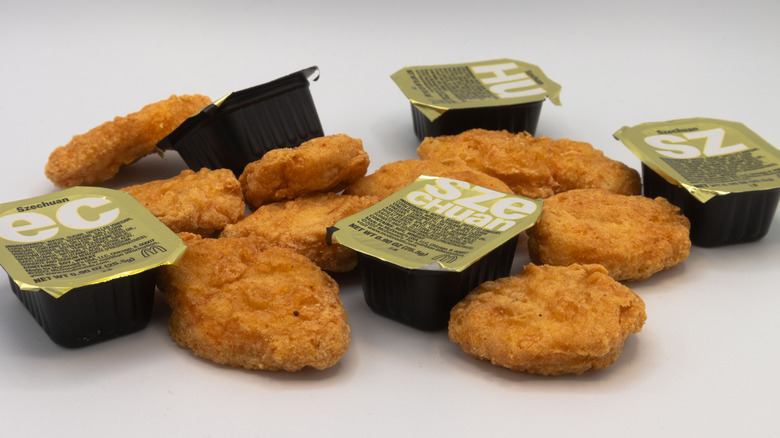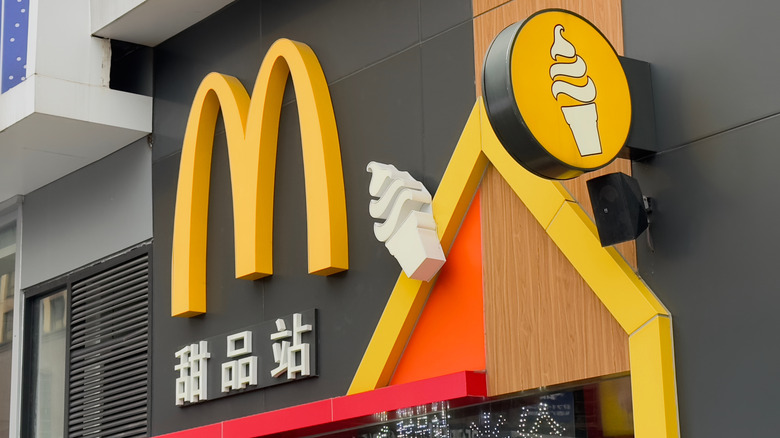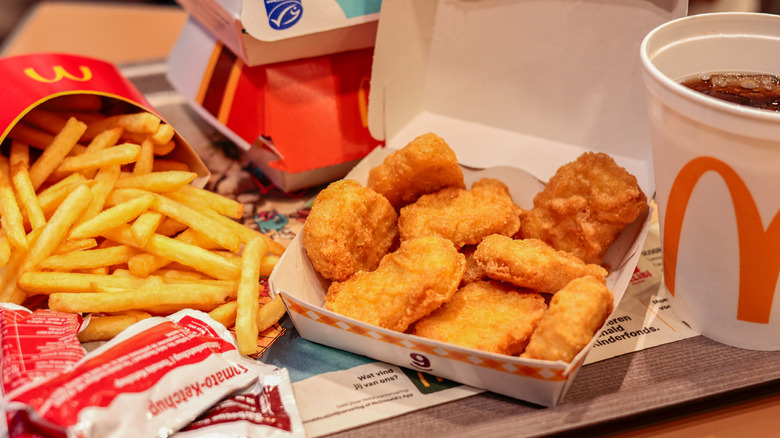9 Facts You Didn't Know About McDonald's Szechuan Sauce
The story of McDonald's mysterious Szechuan sauce is one of the stranger tales of fast food fads. What was originally a minor blip on a promotional timeline evolved into a monster that highlighted the lack of communication between McDonald's marketing department and a major cartoon fandom of the time. McDonald's has since gained a much better understanding of how to handle the sauce's availability, but the events that gave Szechuan sauce its notoriety will never be forgotten.
The Szechuan sauce in question was a dipping sauce for the brand's Chicken McNuggets that was available for a short time (not to be confused with the best McDonald's nugget sauce, which includes a bit of white wine). Szechuan sauce was originally a tie-in product promoting Disney's 1998 animated movie "Mulan," but almost 20 years later, the sauce once again entered the spotlight when the popular cartoon "Rick and Morty" referenced it in one episode. What happened after that was almost unbelievable — and frightening for many of the staff at McDonald's restaurants. Here are some facts about McDonald's beloved Szechaun sauce.
It wasn't supposed to come back
It sure doesn't seem like it now, but originally, Szechuan sauce wasn't supposed to come back after its initial 1998 run. It was a Happy Meal promotional tool for a movie and was expected to fade away once McDonald's pivoted to its next movie tie-in. Nobody was asking for the sauce to return, and it had pretty much become a piece of McDonald's trivia to which no one gave a second thought. In another world, the sauce likely would have faded into obscurity within the confusing history of McDonald's Happy Meals.
Of course, that all changed when the popular cartoon "Rick and Morty" referenced the sauce in one episode, after which a chef tweeted about it. This likely would have gone unnoticed, but this particular food guru was Mike Haracz, a corporate chef for McDonald's, and he and the company decided to extend the joke by mixing up a few bottles of the sauce and sending it to the show's creators. One of those creators then mentioned at San Diego Comic-Con in 2017 that he might be getting some of the discontinued sauce, later posting a tweet showing the large jug he received. At that point, Szechuan sauce was firmly on the minds of "Rick and Morty" fans across the U.S.
The 1998 ads for the sauce were criticized for stereotyping
As you'd expect, McDonald's released a series of commercials promoting the "Mulan" Happy Meal in 1998. Unfortunately, these didn't age very well, as they mostly consisted of the actors making a series of stereotypical bows and martial arts poses. Horrible puns dominated the advertising on containers, and one commercial even showed Ronald McDonald chopping the commercial's tag line in half. While it's true that Disney's "Mulan" is the story of a young girl donning a disguise to join the army, and martial arts are part of the film to a degree, the ad campaign clearly didn't convey that connection. Instead, the whole thing looked incredibly cartoonish — in a bad way.
Both Disney and McDonald's claimed that they had tested the ads before a group of Asian-American employees, but that didn't matter to people who already thought the ads were tasteless. Many people had more severe impressions of the ad campaign, calling it offensive. Both companies were surprised at the response, but luckily, the promotion lasted only a couple of weeks.
McDonald's version is nothing like what you'll find in Sichuanese cuisine
It's probably no surprise that McDonald's recipe for "Szechuan" sauce doesn't actually mimic the numbingly spicy cuisine of Sichuan. Historically, changes to Chinese recipes made in the U.S. are a result of ingredient limitations. Believe it or not, these dishes weren't originally made for American consumers — they were initially made for other Chinese folks, but cooks simply didn't have access to the same ingredients that they did in China. A form of this limitation continued even into the 2000s, at which point the import ban on Sichuan peppercorns was finally lifted.
In McDonald's case, the sauce's cultural inaccuracy wasn't so much due to a lack of ingredients as it was a tactic to make the sauce kid-friendly. At the time, the company already had a recipe for sweet Thai chili sauce that was in use in McDonald's Asian locations (which feature a different menu that its American restaurants), and the creators of the Szechuan sauce recipe simply modified the chili sauce recipe. They did remove any spice, however, because they wanted to be sure that kids would like the sauce. Even if some children are okay with spicy food, many aren't, and the Szechuan sauce was meant for everyone to eat.
The reference in that Rick and Morty episode was a passing joke
The "Rick and Morty" episode that kicked off the rush for Szechuan sauce aired on April 1, 2017. As we've established, McDonald's decided to play along for a while, even sending some freshly mixed sauce to the show's creators. Once that occurred, however, the situation took on a life of its own.
Fans of the show immediately started a petition to get the Szechuan sauce back in stores, and McDonald's listened — kind of. The brand understood that there were people who wanted to try the sauce because of the cartoon. But when the company announced a limited return of the sauce in 2017, it sent only a few packets to select locations, intending for the packets and some posters to be given away in a raffle for one day only. However, McDonald's sorely underestimated the sheer dedication (and number) of "Rick and Morty" fans.
People camped out in front of stores before they opened (with some of these folks even donning costumes), and at one McDonald's in Los Angeles, so many people were competing for sauce — 300 people for 20 packets — that police had to be called to break up fights. There were reports that people stole food from other locations, and in one extreme case, a man jumped up on the counter of a McDonald's and proceeded to yell at employees before rolling around on the restaurant's floor. Mike Haracz, the chef who tweeted about the sauce after the "Rick and Morty" episode aired, received death threats. There was even a reported stabbing at one location, though this was never confirmed.
People have paid ridiculous sums for the sauce
McDonald's 2017 Szechuan mess resulted not only in riots but also in some pretty questionable trades. People were so determined to get their hands on the sauce that some were paying hundreds of dollars for packets on eBay. One packet that somehow survived since the sauce's initial 1998 run fetched a stunning $14,700. (Okay, the sale was for more than just that one packet — the seller included some wasabi, too.)
The demand was so great that people began bidding on eBay for pictures of the sauce, T-shirts showing the sauce, and even drawings of the sauce. One photo of an open packet of sauce (which didn't even prove that it was Szechuan — it could have been any McDonald's sauce packet) was at one time going for $1,525. Possibly the most amazing trade, though, was when a woman who got some of the sauce during the 2017 release traded one packet for an entire car. Yes, it was a used car, but that's still quite an accomplishment.
The 2018 release was not as chaotic but also not as enthusiastic
In 2018, McDonald's decided to release the sauce again so the brand could get back into fans' good graces. This time, the company made 20 million packets available in hopes of avoiding a repeat of the previous year's events. The release was better controlled, and no police calls were necessary, but allowing more people to get a taste of the sauce had another unintended result.
The crowds that demanded the sauce in 2017 were no longer an issue, but the company at last had to deal with the reviews of the sauce's flavor — and those reviews were not as enthusiastic as you might think given the 2017 demand. Many enjoyed the flavor but commented on the lack of spice; others were completely underwhelmed. One Reddit user posted a cartoon panel in the "Rick and Morty" subreddit with the caption, "This just tastes like soy sauce with extra steps." Some of the replies to that post recommended getting Chick-fil-A's sauces instead.
The 2022 app-only promotion was likely a marketing ploy
In March 2022, McDonald's fans got a nice surprise when the chain let them know that in 10 days, they would once again get their Szechuan sauce. The one catch was that they had to use the McDonald's app (one of the 14 fast food apps that we think is actually worth using) to order Chicken McNuggets, at which point they could receive the sauce as a free side. Perhaps surprisingly, people couldn't get the sauce by ordering in person. This was convenient and helped avoid a crush at individual restaurants, but that probably wasn't McDonald's primary motive for this rollout.
The chain likely used the desire for Szechuan sauce as a promotion for its app. This was a great move for the marketing department — more people using the app to order can give the company more information about customer choices and behavior. It's like turning on personalized ads when using social media. This information tells the company what to send your way because you're more likely to watch ads and buy deals that are closely aligned with your interests. This, of course, just translates into more money for the brand.
McDonald's tried releasing the sauce in China
After re-releasing the sauce in the U.S. in February 2018, McDonald's released the sauce in China. The reaction was about what you'd expect. Americans who lived in the country loved it, lining up to get a taste and relive fond memories. Chinese customers, however, had no idea why the sauce was so popular. Most reviews were in the mediocre to bad range, and when the South China Morning Post filmed some staff members and customers trying it, the reaction was unenthusiastic. One woman calmly said it was good, but she also said it was "sweet and sour" and tasted like black pepper. That description is nothing like the sauces you'll find in real Sichuan cuisine.
One Reddit user helpfully explained the difference. First, Sichuan is a large region, so there's no one "Sichuan sauce" in its cuisine. There is a highly spicy chili oil that's commonly eaten, which contains chili powder, chili flakes, and onions. But those who tried McDonald's version often compared it to Japanese teriyaki sauce instead.
So far, rumors of a 2025 release are just rumors
Rumors that the sauce will return to the U.S. in 2025 are just that — rumors. These float around periodically, and the fact that news about older releases shows up in search results doesn't help. McDonald's doesn't typically give a lot of notice regarding when the sauce will return, so you can't really rely on information about a supposed return that's still several months away. Also, be wary of people making random claims online about the return of Szechuan sauce, as these are often jokes.
As of this writing, while there are big changes coming to McDonald's in 2025, there are no reported plans to bring back Szechuan sauce. Releases in other countries aren't even a good indicator of whether or not the sauce will return in the U.S. — when the sauce was briefly released in Canada in 2024, there was no corresponding U.S. rollout. The sauce's releases are limited because that builds up more hype and anticipation. It's a simple rule of marketing and business, and McDonald's has realized that fans' view of the sauce as desirable is at least partly due to its limited availability.
Static Media owns and operates Chowhound and Mashed.
